CUBA TODAY: WHAT REMAINS OF THE DREAM – AND THE NIGHTMARE
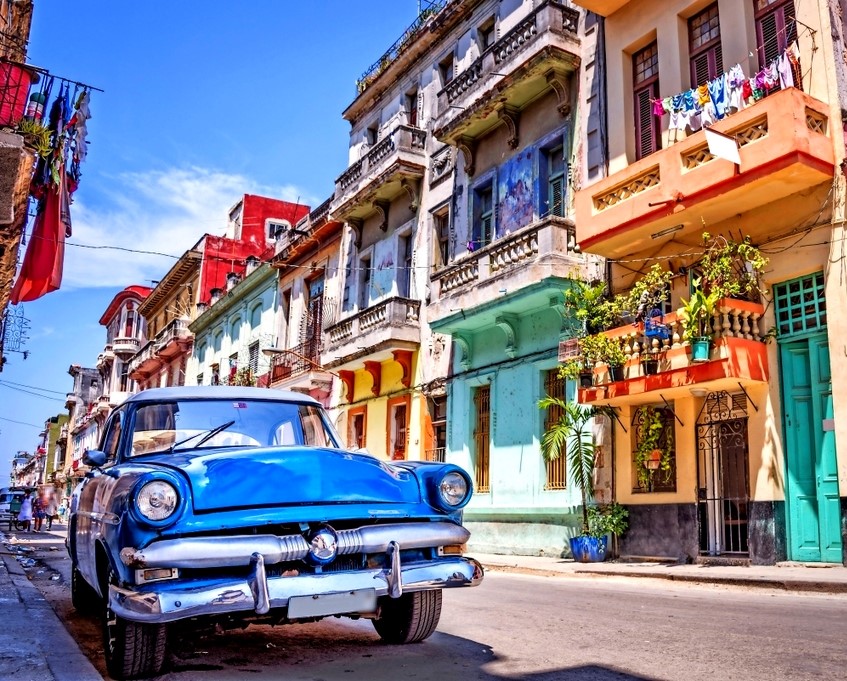
War is not absolutely necessary to destroy a people. In a globalized world where trade lays the foundations for the fight against hunger and poverty everywhere, economic sanctions are an exceptional tool to condemn a people to poverty: to prevent a country from selling the products it abounds and prevent him from buying what he lacks and prohibit him from buying that which is necessary to advance scientifically and technologically. There are currently few examples in the world of this ploy to wipe out a people: especially Turkey’s attempt in Kurdistan, which is accompanied by so many horrific tales of brutal oppression by tyrannical regimes.
There is also a special case, that of Cuba: a small harmless country against which the United States has unleashed all possible anger for more than 60 years. A country that was wrong to choose a strictly self-sufficient (and anti-democratic) way of solving three very serious problems: the endemic delay in production; the high level of commercial indebtedness, which slows down the economy and prevents any form of progress; the seizure of power by a savage tyranny led by the American mafia, American industry and the secret service. A choice which was punished by sanctions which are not as severe in any other region of the planet. Cuba is not being punished because it is undemocratic, but because it rejects American hegemony.
Thirty years after the end of the Soviet Union, the time has come to dispel certain stereotypes. Things we loved to believe in and which may have been the subject of decades of propaganda – like the existence of communism in Cuba, following the USSR’s claims by Nikita Khrushchev and Leonid Brezhnev on the one hand, and the America of John Fitzgerald Kennedy on the other hand.
Cuba is a dictatorship, but unlike other regimes that have succeeded Central and South America, it is not ruled by an oligarchy that starves a people; it is not a mafia gang, but on the contrary, it was planned as an extreme (and successful) attempt to emancipate itself from the fate that the Monroe Doctrine, Washington’s political and military interference in all countries of the continent considers legitimate[1], produced for all, such as Chile of Pinochet, Videla’s Argentina, Nicaragua of the Somoza clan and other cruel military dictatorships: regimes that have exterminated thousands of people and kept them in misery and fear just for please the United States[2].
Today, more than 60 years after the revolution, Cuba is still looking for its “third way”, accepting the practical premises of post-capitalism, one after the other, and not opening up to the United States. , which it is rightly suspicious of, but to the European Union and what our market system can offer. It is therefore high time to understand how things really go in Havana.
What was really in the previous episodes
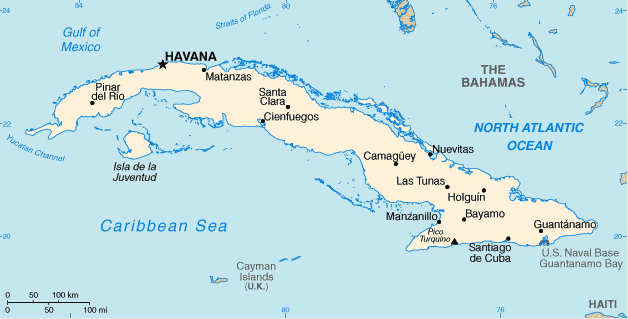
Cuba and just 50 miles north is the farthest offshoot of Florida[3]
Cuba, the dream of generations, music and lightness, poetry, poverty and revolution. A few miles from the American coast, Cuba has a unique place in the collective imagination, but has also been a hub of the conquering ambitions of all colonial states beyond the clichés of 500 years of European invasion. After having exploited the gold deposits, the conquistadors switched to tobacco, coffee and finally sugar cane, the island’s most important economic engine[4]. These are stories of military occupation, humiliation, slavery. In the centuries that have passed since 1492, when Christopher Columbus anchored off Cuba and discovered the enormous wealth of this beautiful island, almost nothing remains of it.
Although independence from Spain was declared in 1868 (but not recognized until 1898), until 1959 the island was either in a civil war of several years or under the colonial rule of the United Statesand the government desired by Washington, the dictatorship of Fulgencio Batista – none other than the corrupt administration of another colonial power[5] subject to the criminal interests of the Italian mafia and the corrupt American secret services[6]: “De facto, there were two Cubans. in which the elite lived beautifully and comfortably and in which the other did not even have the bare necessities to survive”[7]. To put it plainly, either you were part of the torturer or you were a victim[8].
Until January 1, 1959, the date of the revolution, led by Fidel Castro[9] and a group of loyalists, including his brother Raúl and Ernesto “Che” Guevara, drove out the oligarchs and members of the Mafia[10]. In an effort to reform the economy and society at the same time, Castro nationalized banks and industries, confiscated property from foreigners and Batista supporters[11] (until then with Washington’s tacit approval), and on May 17 1959 proclaimed land reform that gave landowners the land taken from them, and only then did the real tension begin[12].
The reform stipulates that agricultural production companies cannot exceed 402 hectares (with very rare exceptions for sugar cane, for which 1,342 hectares have been approved, but on the condition that the farms are converted into Cuban cooperatives) and, more, that the land was divided into plots of 27 hectares and distributed to laborers and laborers[13]. For the United States, whose agricultural supply chain has relied on cheap Cuban produce for various productions, this is a disaster[14]. Understanding that it was the central node of the whole revolution, the Revolutionary Council created the INRA (National Institute for Agrarian Reform)[15] and handed it over to Fidel Castro personally and to his closest collaborators[16].
Castro promulgates a mining law that follows the agricultural law: 25% tax on the profits of foreign mining industries, 100% tariff on imported products[17]. Luxury becomes a danger, and no one earns enough to be able to afford it: between 1959 and 1975, more than 600,000 Cubans left the island, to be precise, in the hope of rebuilding the rich and decadent Cuba during the years of Batista[18]. All that smacks of the dictatorship of the proletariat and therefore the Soviet Union for an America steeped in McCarthyism.

April 19, 1961: Fidel Castro celebrates the victory of his comrades after the victory in the Bay of Pigs[19]
Although Fidel Castro always denied this (he just wanted a country with no foreign debt and no land aristocracy), in May 1960, the tankers of Esso Standard Oil, Texaco Oil and Shell blocked oil imports into Cuba and refused to transform crude oil originating in the USSR[20]. Washington imposes restrictive measures on imports of Cuban sugar on July 6, 1960[21]. Both measures (rather than ideology) lead Castro to nationalize the banks[22] and the United States to impose a total embargo (excluding food and drugs)[23].
It was only then that the Cuban revolution turned to Moscow with its back to the wall: Washington broke off diplomatic relations [24] and, as usual, the United States staged a coup to get rid of Castroism. In April 1961, armed forces made up of Cuban exiles armed by the USA land in Cuba, in the Bay of Pigs, but they are destroyed: at the last moment, President Kennedy did not want to officially declare war, but from that day Cuba’s isolation became irrevocable[25].
While the economic effects are already damaging, the social consequences are surprisingly severe. Once gambling and prostitution are eliminated, a free health system and social security are born, the government launches a vast program of forced education which in five years will reduce the number of illiterates from 25% to 4% of the population and will lead a generation, that is on the streets or has lived in the field, to study in universities[26] because private schools and class differences are abolished[27]. Before the revolution, almost 90% of rural farmers were in poverty, without running water, without electricity, without medical aid[28]. After the revolution, 150,000 families became landowners, and social infrastructure was completed in record time – mainly medical care, made possible by the promotion of free university studies that became open and accessible to all[29].
All this in a situation where food and energy are scarce, where heavy industry is totally absent, where the American embargo makes economic growth impossible, but at least Cuba (thanks to Soviet support) has no debt and meticulously regulated prices, at least until Fidel Castro’s death[30]. However, the dream of salvation associated with the development of the five-year plans and the central planning authority fails due to the lack of raw materials and trade. This forces the state to continue lowering living standards – at least until 2011, when Raúl Castro distributed state-owned land to farmers to increase food reserves[31] and launched a program to encourage creation of small businesses[32].
With the end of the Soviet Union (which provided Cubans with essential fertilizers), agriculture declined for several centuries and even sugar factories began to close[33]. It is only since this century that things have improved a little thanks to new investments from Canada and the European Union (starting with fishing)[34]. The opening up to tourism has also convinced the government to allow the opening of public stores of imported products to those who have foreign currency in hand[35].
What remains of 30 years of alliance with the Soviet Union
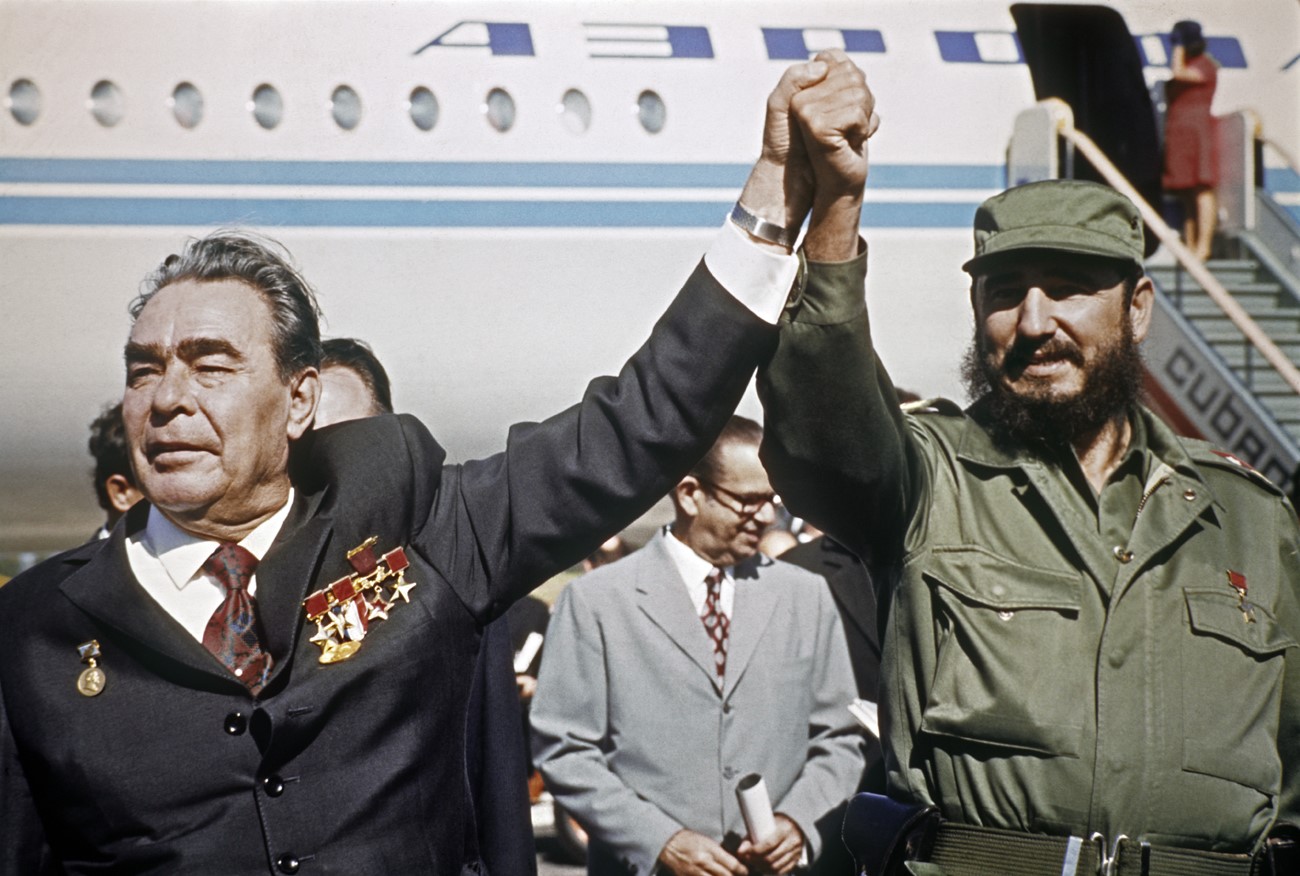
January 28, 1974: Leonid Brezhnev welcomes Fidel Castro at José Martí airport in Havana[36]
Beware of pro-American propaganda: Until it was stranded in the Bay of Pigs, the Soviet Union viewed the Cuban revolution with suspicion. After that day, Fidel Castro wrote to Nikita Khrushchev for help, and it was only then that the attitude of the Kremlin changed and the USSR sent weapons, technicians and instructors to teach Cubans how to defend themselves[37]. While nearly 70% of Cuban trade with the United States took place in the last decade, it fell to 4% after the Bay of Pigs, and it remained that way until the dissolution of the Soviet Union in 1991[38].
By then, relations between the USSR and Cuba had already deteriorated considerably. In return for trade, oil and military aid, the Soviet Union demanded and received that Cuban soldiers fight all over the world to defend the allied regimes in Moscow: 50,000 in Angola, 15,000 in Ethiopia, then in Libya, Algeria, Mozambique, the time you were there, alone, in Grenada, when a Kremlin propaganda operation ended in 1983 with an American grounding on an island that was only occupied by Cuban troops[39]. But Fidel had already become extremely critical since Khrushchev agreed to leave the island at the end of the Soviet nuclear missile crisis in Cuba in exchange for the US renouncing missiles in Turkey and a general promise that the United States would not would not invade Cuba[40]. As Mikhail Gorbachev came to Havana on April 2, 1989, the atmosphere between the two heads of state was anything but idyllic[41].
Over the years, the Cuban government’s intolerance of the USSR’s colonial position grew until Havana was left alone. At this point, Castroism has to make pragmatic decisions: until then, full employment was only guaranteed by very low wages and jobs in public enterprises[42] and sugar plantations, even if they were bought in a currency almost unusable like the ruble[43].

Evolution of Cuba’s gross domestic product (GDP) over the years, in billions of dollars[44]
After 1991, Cuba opened up to tourists and the weight of sugar in export volumes fell dramatically – suddenly remittances from relatives living abroad were a vital resource (over half of the trade balance) because the government allowed payment in dollars[45]. Result: Cuban GDP has grown by an average of 6% per year since 1991[46]. Measures against unemployment are less and less necessary: tourism today employs nearly 60% of the working population and contributes more than 40% to the sum of Cuba’s gross domestic product[47].
The average salary in Cuba is 27 euros per month (around 900 pesos), but for 60 years this has not been a problem because every Cuban citizen who has a commissary book was entitled to free groceries and products of first need[48]. This measure could work as long as (as in the Warsaw Pact countries) the state owned real estate, industrial, agricultural and financial assets[49] and as long as the opportunity to work for a foreign company was accompanied by special quarterly permits[50]. In November 2020, the government admitted the privatization and canceled the committee book. The result is that more than 550,000 Cubans, now starving, have left the island in search of work[51], and the rest are desperate and indignant – especially when they see photos of Tony Castro, Fidel’s nephew living in this decadent luxury, which his grandfather had promised to fight[52].
The longest and most unfair embargo in human history
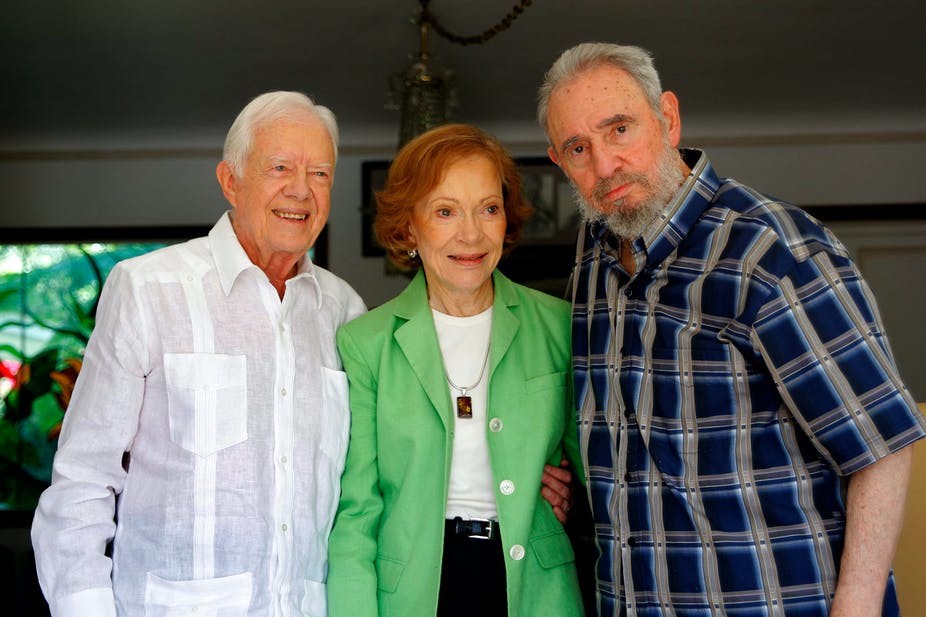
March 30, 2011, Havana. From left to right: Jimmy Carter, his wife Rosalynn, Fidel Castro[53]
The embargo against Cuba cannot be justified by an international convention. Cuba does not have weapons of mass destruction, it does not finance or support acts of terrorism, it is not affiliated with any organized crime group, and it is certainly not a regime more undemocratic than that of several ones protected by the United States for decades. For Washington, however, this is not enough: in 1996, the United States Congress approved the Helms-Burton Act, under which anyone, even outside the United States, has the shamelessness to trade with Cuba to accept retaliation. legal documents of the US military[54].
The anger of the United States that Havana rejects American domination and refuses to pursue an economic policy of indebtedness did not end with the end of the Cold War and the demise of the Soviet Union: today Washington maintains friendships and alliances with bloody people and despotic regimes like Turkey, Saudi Arabia, the Emirates, but continues to slam the door in the face of Cubans.
In 1996, Fidel Castro also sought the help of the Catholic Church and invited the Pope, and John Paul II’s visit in 1998 was a resounding success[55]. Former President Jimmy Carter visited Cuba in May 2002 and spent his time lobbying to end the embargo. He then visited Cuba several times, and he and Castro became good friends[56]. Without results. In October 2011, the United Nations General Assembly approved a motion calling on the United States to lift the embargo by 187 votes in favor, 2 against (Israel and the United States) and 3 abstentions (the small states of Palau, Marshall Islands and Micronesia). The United States vetoed it[57]. In 2017, there was the 24th vote against with 191 votes for and 2 against (USA and Israel), and the results of the vote have been repeated every year[58], although the whole world (first the European Union[59]) insists still on the fact that the embargo is an attempt at genocide is[60]. Yet as long as a single state is empowered to say NO, Cuba is doomed to fail[61].

US President Barack Obama during his visit to Cuba in 2016[62]
In January 2005, the European Union finally lifted the embargo[63]. The Americans limited themselves to an amendment (2002) that allowed companies to sell groceries, but did so for “humanitarian reasons” and complained that Cuba, which could not buy oil from another country, had started to buy it in Venezuela[64]. Their mood deteriorated when the Castro government began to develop trade relations with China over the past decade[65]. All palliative care: The state has less and less money, and over the past decade, the level of personnel and infrastructure in the health[66] and school systems has deteriorated sharply[67].
Only Barack Obama made serious attempts to change things, despite the lack of a majority in Congress[68]. After an exchange of prisoners, official diplomatic relations resumed on December 17, 2014 and major tourist openings were made[69]. When he arrived at the White House, Donald Trump canceled everything[70] and then imposed a series of 190 new economic sanctions[71], some of which were backed by military measures (which prevent Corporación Panamericana SA from transporting Venezuelan oil and Russian gas to the port of Havana[72]). In addition, there is the order to freeze the funds of those who, after the death of Fidel Castro and the liberalization of Cuban law, began to invest in Cuban real estate through tax havens[73].
Yes, because for a very long time (since the early 1980s) the Havana government started creating offshore companies to obtain hard currency: the ICIJ’s investigations into documents stolen from the Panamanian trust company Mossack y Fonseca revealed how several Cuban companies began doing certain business transactions outside of Cuba through a network of companies incorporated in Panama, the Virgin Islands, the Cayman Islands and Barbados[74]. Also in this case, it is a special procedure: the 13 offshore companies identified by the ICIJ[75], all of which have already been liquidated (with one exception), have not served to enrich certain oligarchs, but have rather put dollars and euros in the half-empty state capital coffers[76], we bring or buy oil and drugs despite American sanctions[77].
American law could not stand one thing: In the last hours of his presidency, Trump gave new measures against state-controlled companies and the Cuban military (FAR Fuerzas Armadas Revolucionarias), hence the holding company GAESA (Grupo de Administración Empresarial SA[78]) and some of its subsidiaries, including companies that market coffee, the state hotel chain and agencies that support the promotion of tourism and communication, real estate, commerce and oil trade[79].
A bet called ZEDM
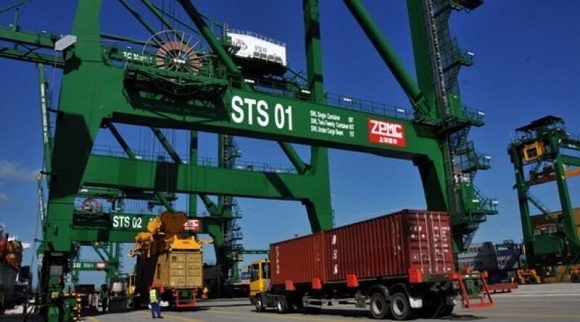
The Mariel Special Development Zone is the largest foreign investment center in the country[80]
Cuba is not alone in the struggle for survival, and it is not true that it is only supported by the Venezuelan dictatorial regime – as the American propaganda would make us believe: from March 2014 and therefore from there The introduction of the liberal reforms of the Ley de Inversión Extranjera, which opened the door to companies around the world[81], launched an international solidarity competition, which is supported by all South American countries, the European Union and development investment banks[82]. In November of the same year, many important personalities were present at the inauguration of the ZEDM (Zona Especial de Desarrollo Mariel[83]), a container terminal of 465 km2 and a storage infrastructure, just 50 km from Havana[84]: the Brazilian President Dilma Rousseff, Venezuelan dictator Nicolás Maduro, heads of state of Bolivia (Evo Morales), Haiti (Michel Martelly), Guyana (Donald Ramotar) and Jamaica (Portia Simpson-Miller)[85].
Faced with allegations of Bolshevism, ZEDM[86] benefits from a number of tax exemptions and reductions,[87] and continues its implementation with a government commitment of $ 300 million per year to expand the logistics area and create offices for businesses foreigners: there is also an Attaché Immigration Service customs office, a branch of BFI Banco Financiero Internacional, fire service, security company, some catering and logistics companies[88]. Between 2014 and 2020, despite the pandemic[89], 55 new businesses (and 11,700 jobs[90]) were created in key sectors such as agribusiness, construction, pharmaceuticals and biotechnology as well as renewable energies (with additional investments in industrial construction on the Isla de la Juventud[91]), electrical and mechanical machinery, chemicals, plastics, metallurgy and medical equipment[92].
ZEDM fundamentally changed the Cuban system step by step. As of 2019, 80% of the money that circulates between the companies represented in ZEDM can be used for direct investments in Cuban territory[93] – and without mediation or state control[94]. The Cuban Central Bank allows accounts to be opened in different currencies – and this has brought the convertibility of pesos, but also the ability to use euros and dollars in everyday life[95].
The results are considerable: BioCubaFarma[96] has created a joint venture at ZEDM (CIGB-Mariel) which now sells the best Cuban biotechnology products to the rest of the world[97]. Vietnamese multinational Thai Binh Global Investment Corporation[98] produces island-wide diapers and panty liners at ZEDM[99]. The Belgian group BDC, in collaboration with the UCI (University of Computer Science), has started to digitize the Cuban domestic market, but mainly produces new sensors and audiovisual devices for the American market[100]. BAT British American Tobacco has also landed at ZEDM and created a joint venture with Cuban tobacco producers (Brascuba Cigarrillos SA[101]), the aim of which is to increase the volume of exports of Cuban tobacco products tenfold[102].
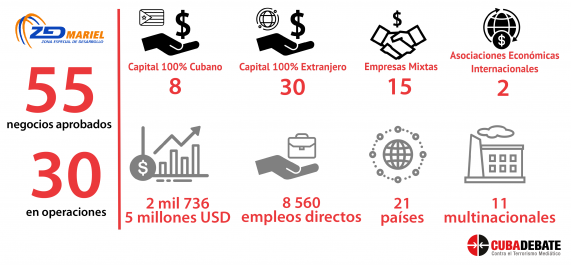
ZEDM sector A projects – the closest to the port – are linked to three sectors: logistics, biotechnology and manufacturing[103]
But this is not enough: Cuban gross domestic product barely exceeds $90 billion per year[104] and corresponds (more or less) to that of Sicily[105], Schleswig-Holstein[106] or Galicia[107]. The average per capita income does not reach 10,000 euros per year[108], but poverty is increasing alongside rising unemployment and the ban on exports of Cuban products, leading more and more people to try to leave the country[109]. In order to avoid this, the government can not only gradually advance the democratization of society and politics, but also strive for technological and infrastructural implementation, and also use some enterprises of absolute excellence which have survived despite sanctions and in the EU in the latter, for years they have experienced constant growth both in the domestic market and in the foreign market.

Habanos SA Avana
All the major Cuban tobacco brands (Bolivar, Cohiba, Montecristo, Partagás, H. Upmann, Romeo and Juliet) belong to a single company, Habanos SA[110], the world leader in artisanal cigars, whose sales continue to grow by 2% per year and now has the widely exceeded limit of half a billion dollars[111]. The company was born in 1994[112] from the ashes of Cubatabaco. It was the acronym for the revolutionary Nationalization Law of 1962[113], which gradually fell into crisis due to deterioration in quality, with the best craftsmen leaving the island in search of better wages elsewhere[114]. In order to support the global marketing and distribution of its products, 50% (in 2000) was sold to Altadis SA Madrid[115], which was taken over by Imperial Tobacco in 2008[116].
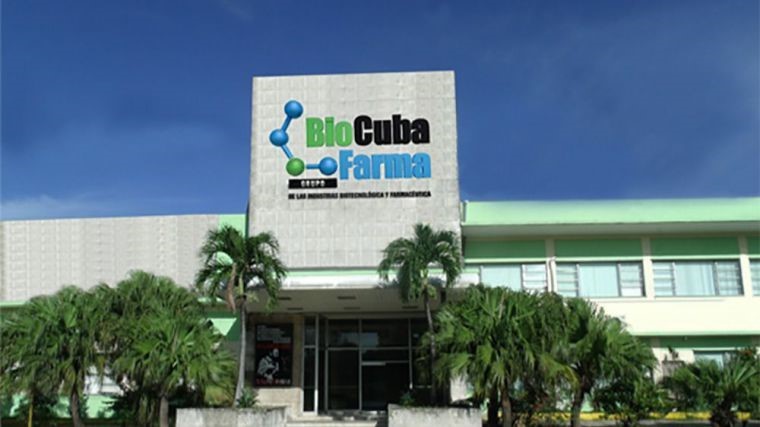
Biotechnology and Pharmaceutical Industries Group (BioCubaFarma) SA Avana
BioCubaFarma is an incubator for 32 small pharmaceutical companies and 65 scientific laboratories across the island, coordinating 80 production lines of as many drugs that are enjoying increasing success in Europe and Asia[117], including various Covid-19 treatment products currently available Completion of the phase of tests and clinical studies[118], as the director Eduardo Martínez Diaz[119] explains, despite the active boycott advocated by Donald Trump: “At the beginning, they focused on shortening our supply chains and on exchanges with researchers from other countries, as well as with the United States. In recent months they have also tried to prevent payments for the imports we need and threaten retaliatory measures against the banks”[120].
Fortunately, the European Union supports these projects and in November 2020, the NGO MediCuba Europa signed an agreement with BioCubaFarma to co-finance the development of these drugs, for which 300,000 euros have already been paid[121]. British company SG Innovations announced (August 2020) the creation of BioFarma Innovations Ltd. London[122], which has applied for the license not only for products related to Covid-19, but also for all other innovative drugs that have been studied by Cubans over the past decade[123].
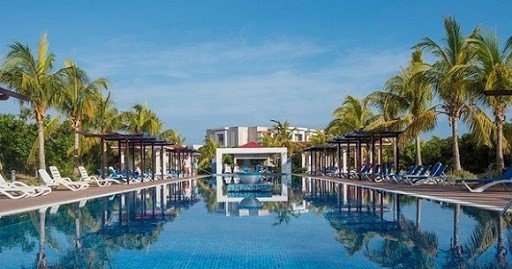
Gaviota Grupo de Turismo SA Avana
The tourist group takes its name from a small fishing boat (“Gaviota”) and has been organizing trips and longer study and work hours for 33 years. It has more than 100 hotels[124]. With all going well, Gaviota will double its capacity by 2025, in part thanks to the acquisition of the Habaguanex SA Havana group and the opening of luxury hotels[125]. In addition to hotels, thanks to Transgaviota, the group organizes excursions, wellness treatments and diving schools[126]. But these are infrastructures that are strongly prohibited by the American authorities because they would help finance obscure terrorism[127]. A real joke, knowing that some of these beautiful hotels on pristine beaches are a stone’s throw from the Guantanamo detention and torture center, which Washington still considers an acceptable institution for a country that claims to be democratic[128].

Havana Club Internacional SA Avana
The company, founded in November 1993, is a joint venture between state-owned CubanaExport (50%)[129] and French multinational Pernod Ricard (50%) and is an extremely successful product not only in France[130]. In 2007, Havana Club International SA[131] opened a new rum distillery in San José[132] to meet growing demand: Havana Club is the third international rum brand in the world and the world leader in premium rum[133]. The company exports to more than 120 countries except the United States, where the Havana Club is banned due to the trade embargo[134]. Before the Cuban Revolution, Jose Arechabala SA (JASA), a family business, owned and produced the “Havana Club” brand. Neither JASA nor its owners have ever received compensation for the confiscation ordered by the Cuban government[135].
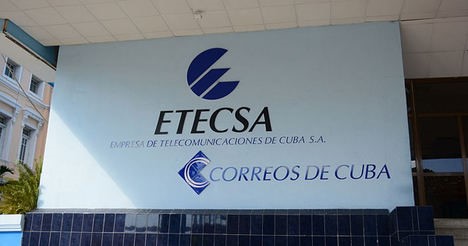
ETECSA Empresa de Telecomunicaciones de Cuba SA Avana
It is the Cuban public telephone company founded in 1994. In 2006, 51% of the shares belonged to a private company with Cuban capital, 29.9% to TIM Telecom Italia and the rest to Cuban and foreign financial companies[136]. In January 2011, TIM fell to 27% and sold 2.9% for $ 706 million to Rafin SA Habana[137]. Today, ETECSA belongs to the Ministry of Information and Rafin[138]. ETECSA has long been used as a tool to monitor and suppress system-critical citizens[139], and even today, after the promise of profound change, the blocking of the use of telegram messages has rightly triggered organizations international human rights organizations[140].
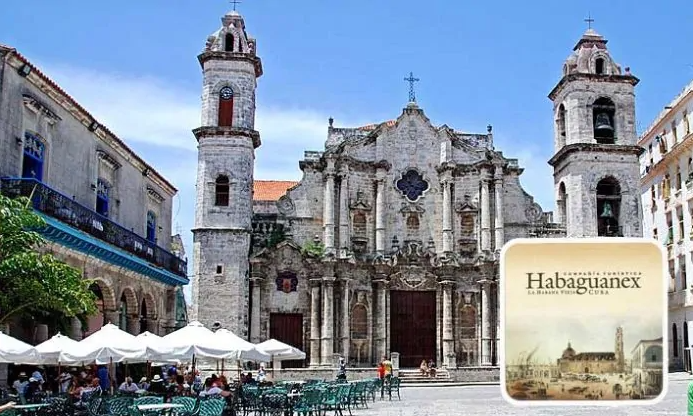
Compañía Turística Habaguanex SA (Habaguanex) Vieja
The company, founded in 1994, was born from the idea of Eusebio Leal Spengler[141], the greatest Cuban historian and one of the continent’s most famous intellectuals[142]. Habaguanex SA offers historic hospitality of great architectural, cultural and historical significance, especially in Old Havana, which has been a World Heritage Site since 1982 thanks to Eusebio Leal and the money the company has invested in the restoration buildings to be restored[143]. Haguanex has 300 buildings of monumental value including restaurants, shops, markets, cafes and 16 hotels and inns with 546 rooms[144]. One of the most famous places is the La Factoría brewery in Plaza Vieja, which was acquired in 2012 after its former owner, Meyci Wess, was arrested and convicted of leading a Mafia clan[145]. Since Habaguanex was incorporated into GAESA in 2016, it is now on the US sanctions blacklist and cannot be used[146].
Un avenir dans la seule direction possible
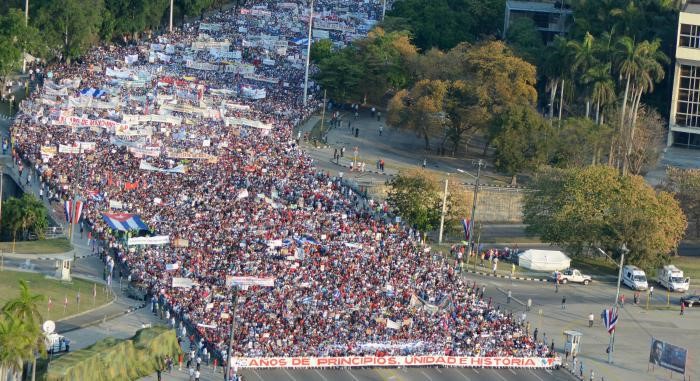
May 1, 2018: Cuba takes to the streets to celebrate International Labor Day, six decades after the revolution, and shares hope for a better future[147]
This is a case of a snake eating its own tail. Washington says it will lift sanctions when Cuba becomes a democratic country. Havana promises democracy if Cuba is free from sanctions. Meanwhile, from October 2020, the newly elected President Miguel Diaz-Canel[148] announced that after the monetary reform (and the abolition of the convertible peso, which weighs like a rock on the state coffers, of 1 peso for 1 dollar) and the disappearance of the “provision book” will lead to the liberalization of all trade (agricultural, food, pharmaceutical, automobile, real estate and banking), which will be adjusted at the expense of the International Monetary Fund[149].
It is clear that the process of unifying the currency and the exchange rate will be accompanied by economic measures such as wage and pension reform, which will increase to keep up with expected inflation, as well as the elimination of what the government considers “unnecessary subsidies” (such as the reserve book). The situation in Cuba, which suffers from a chronic balance of payments deficit, is exacerbated by the pandemic (which has wiped out tourism) and the tightening of sanctions imposed by the United States over the past two years[150].
In February 2021, the Cuban government approved private activities in most sectors[151] and implemented the agreements made with Barack Obama[152] seven years ago in the hope that Joe Biden will resume the dialogue that Donald Trump interrupted. From July 2019, the Internet will finally be free and accessible to all[153]. The cost remain high but will decrease over time. Cubans are thirsty for information and the authorities have realized that they cannot stop the tide[154]. The task now is to understand whether even one of the most conservative and undemocratic powers in history (the United States) will be able to leap beyond its shadow and help Cubans be free, independent and empowered to manage their own happiness in peace.
ESP001
[1] https://web.archive.org/web/20120108131055/ ; http://eca.state.gov/education/engteaching/pubs/AmLnC/br50.htm
[2] https://unsaltoneltempo.jimdofree.com/julio-velasco/le-dittature-in-america-latina/
[3] https://st.ilsole24ore.com/art/SoleOnLine4/Mondo/2008/02/scheda-cuba.shtml
[4] Trento A., “Castro e Cuba: dalla rivoluzione a oggi”, Giunti, Firenze 1997; https://www.britannica.com/place/Cuba
[5] Salim Lamrani, “Washington contre Cuba. Un demi-siècle de terrorisme”, Le Temps des Cerises, Montreuil 2005
[6] https://www.dailymotion.com/video/xsoirq
[7] Howard I. Blutstein. “Area Handbook for Cuba”, US Government Printing Office, Washington DC, 1976. Page 185; https://tesi.luiss.it/20145/1/077552_BARTOLETTI_LORENZO.pdf
[8] Umberto Melotti, “La rivoluzione cubana”, I Corvi, Edizioni Dall’Oglio, Milano 1967; Lorenzo Bartoletti, “La Rivoluzione Cubana e Fidel Castro: un comunista imperfetto”, Dissertazione, Università LUISS, Milano 2017 – see in https://tesi.luiss.it/20145/1/077552_BARTOLETTI_LORENZO.pdf
[9] https://www.istitutocapialbi.edu.it/zanzara/cronaca/175-fidel-castro-tiranno-o-liberatore.html
[10] https://www.treccani.it/enciclopedia/rivoluzione-cubana_%28Enciclopedia-dei-ragazzi%29/
[11] http://it.granma.cu/cuba/2019-05-16/una-riforma-che-ha-illuminato-la-terra
[12] Huberman L., “Cuba: Anatomia di una rivoluzione”, Einaudi, Torino 1961; http://www.granma.cu/idiomas/italiano/cuba/16mayo-reforma.html ; Tesi di Laurea “La Rivoluzione Cubana e Fidel Castro: un comunista imprefetto” di Bartoletti Lorenzo https://tesi.luiss.it/20145/1/077552_BARTOLETTI_LORENZO.pdf
[13] http://it.granma.cu/cuba/2019-05-16/una-riforma-che-ha-illuminato-la-terra ; Trento A., Castro e Cuba: dalla rivoluzione a oggi, Firenze, Giunti, 1997
[14] Tesi di Laurea “La Rivoluzione Cubana e Fidel Castro: un comunista imprefetto” di Bartoletti Lorenzo https://tesi.luiss.it/20145/1/077552_BARTOLETTI_LORENZO.pdf ; F. Sergeev. Guerra segreta contro Cuba. M., “Progress”, 1982. p.31-33
[15] http://www.granma.cu/idiomas/italiano/cuba/16mayo-reforma.html
[16] Tesi di Laurea “La Rivoluzione Cubana e Fidel Castro: un comunista imprefetto” di Bartoletti Lorenzo https://tesi.luiss.it/20145/1/077552_BARTOLETTI_LORENZO.pdf
[17] E. A. Grinevich, B. I. Gvozdarev. Washington vs L’Avana: la rivoluzione cubana e l’imperialismo statunitense. M., “Relazioni internazionali”, 1982. p. 40-42
[18] https://www.ilpost.it/2016/03/24/i-cubani-di-miami/ ; https://www.iodonna.it/attualita/storie-e-reportage/2015/06/01/miami-laltra-cuba-che-sogna-di-avere-una-chance-sul-suolo-yankee/
[19] https://m.notimerica.com/politica/noticia-invasion-bahia-cochinos-fallido-intento-eeuu-derrocar-fidel-castro-20170417083600.html
[20] E. A. Grinevich, B. I. Gvozdarev. Washington vs L’Avana: la rivoluzione cubana e l’imperialismo statunitense. M., “Relazioni internazionali”, 1982. p. 45
[21] E. A. Grinevich, B. I. Gvozdarev. Washington vs L’Avana: la rivoluzione cubana e l’imperialismo statunitense. M., “Relazioni internazionali”, 1982. p. 40-42
[22] E. A. Grinevich, B. I. Gvozdarev. Washington vs L’Avana: la rivoluzione cubana e l’imperialismo statunitense. M., “Relazioni internazionali”, 1982. p. 40-42
[23] E. A. Grinevich, B. I. Gvozdarev. Washington vs L’Avana: la rivoluzione cubana e l’imperialismo statunitense. M., “Relazioni internazionali”, 1982. p. 46
[24] https://www.treccani.it/enciclopedia/rivoluzione-cubana_%28Enciclopedia-dei-ragazzi%29/
[25] https://www.treccani.it/enciclopedia/rivoluzione-cubana_%28Enciclopedia-dei-ragazzi%29/
[26] Castro J., I miei fratelli Fidel e Raúl . La storia segreta, Miami, Fazi, 2010; Tesi di Laurea “La Rivoluzione Cubana e Fidel Castro: un comunista imprefetto” di Bartoletti Lorenzo https://tesi.luiss.it/20145/1/077552_BARTOLETTI_LORENZO.pdf
[27] https://www.britannica.com/place/Cuba/Political-process
[28] Libro “Perchè la Rivoluzione Cubana?” e “Censimento di Popolazione e Casa” del 2012, Annuario Statistico di Cuba 2017 e “Mesa Redonda” della TV ; http://it.granma.cu/cuba/2019-05-16/una-riforma-che-ha-illuminato-la-terra
[29] Libro “Perchè la Rivoluzione Cubana?” e “Censimento di Popolazione e Casa” del 2012, Annuario Statistico di Cuba 2017 e “Mesa Redonda” della TV ; http://it.granma.cu/cuba/2019-05-16/una-riforma-che-ha-illuminato-la-terra
[30] https://www.britannica.com/place/Cuba
[31] https://www.britannica.com/place/Cuba/Demographic-trends
[32] https://www.britannica.com/place/Cuba
[33] https://www.britannica.com/place/Cuba/Agriculture-forestry-and-fishing
[34] https://www.britannica.com/place/Cuba/Agriculture-forestry-and-fishing
[35] https://www.britannica.com/place/Cuba/Political-process
[36] https://www.nytimes.com/1974/01/29/archives/brezhnev-begins-visit-to-havana-trip-soviet-leaders-first-to-last.html
[37] https://dic.academic.ru/dic.nsf/ruwiki/683934
[38] https://www.britannica.com/place/Cuba/Trade
[39] https://www.britannica.com/place/Cuba/Local-government
[40] https://rg.ru/2017/09/09/rodina-karibskij-krizis-razviazka.html ; https://cubanos.ru/texts/kk09 ; https://function.mil.ru/news_page/country/more.htm?id=11415875@cmsArticle
[41] https://www.gazeta.ru/science/2019/04/02_a_12279439.shtml
[42] https://www.britannica.com/place/Cuba
[43] https://cubanos.ru/texts/kk09
[44] https://www.indexmundi.com/g/g.aspx?c=cu&v=65&l=it
[45] https://www.britannica.com/place/Cuba
[46] https://www.sapere.it/enciclopedia/Cuba.html
[47] https://www.sapere.it/enciclopedia/Cuba.html
[48] https://www.quotedbusiness.com/thm-17-economia/paese-173-cuba/art-5971-i-cubani-non-avranno-piu-il-libretto-di-approvvigionamento
[49] Comments: https://www.marcopolo.tv/vivere-cuba
[50] https://www.marcopolo.tv/vivere-cuba
[51] https://www.tpi.it/esteri/cuba-stipendio-medio-28-euro-mese-20190422297050/
[52] https://www.tpi.it/esteri/tony-castro-instagram-cuba-fidel-20190107228506/ ; https://www.instagram.com/tonycastro.u/
[53] https://theconversation.com/jimmy-carter-in-cuba-46109
[54] https://www.govinfo.gov/content/pkg/PLAW-104publ114/pdf/PLAW-104publ114.pdf
[55] https://www.sapere.it/enciclopedia/Cuba.html
[56] https://theconversation.com/jimmy-carter-in-cuba-46109
[57] https://web.archive.org/web/20151117142718/https://it.notizie.yahoo.com/cuba-per-la-ventesima-volta-onu-condanna-embargo-171700215.html ; https://lenta.ru/articles/2020/10/20/cuban_sanctions/
[58] https://undocs.org/A/71/L.3
[59] https://www.europarl.europa.eu/sides/getDoc.do?type=REPORT&mode=XML&reference=A4-1996-0329&language=EN
[60] https://news.un.org/en/story/2019/11/1050891 ; https://www.un.org/en/ga/62/plenary/cuba/bkg.shtml
[61] http://www.cubavsbloqueo.cu/sites/default/files/InformeBloqueo2016ES.pdf
[62] https://lenta.ru/articles/2020/10/20/cuban_sanctions/
[63] https://www.sapere.it/enciclopedia/Cuba.html
[64] https://www.britannica.com/place/Cuba/Trade
[65] https://lenta.ru/articles/2020/10/20/cuban_sanctions/
[66] https://www.ncbi.nlm.nih.gov/pmc/articles/PMC1380757/ ; https://www.acpjournals.org/doi/abs/10.7326/0003-4819-132-2-200001180-00010?journalCode=aim
[67] https://www.quotedbusiness.com/thm-18-strategie-regole/paese-173-cuba/art-918-finisce-l-era-dei-castro-si-apre-un-cambiamento-epocale
[68] https://lenta.ru/articles/2020/10/20/cuban_sanctions/
[69] https://www.bbc.com/news/world-us-canada-30516740 ; https://www.pwc.com/us/en/financial-services/regulatory-services/publications/assets/2014-cuba-sanctions.pdf ; https://web.archive.org/web/20141218093615/https://ijsbergmagazine.com/international/article/14183-un-nouveau-chapitre-souvre-entre-les-etats-unis-et-cuba/
[70] https://rg.ru/2020/09/23/ssha-uzhestochili-sankcii-protiv-kuby.html ; https://lenta.ru/articles/2020/10/20/cuban_sanctions/ ; https://www.notiziegeopolitiche.net/cuba-nuove-sanzioni-da-parte-dellamministrazione-trump/
[71] For Americans traveling to Cuba, new restrictions have been introduced on the use of Cuban government-owned hotels. Additionally, US citizens are prohibited from bringing home Cuban rum or cigars – these goods are also on the list of restrictions announced in September 2020, see also: https://rg.ru/2020/09/23/ssha-uzhestochili-sankcii-protiv-kuby.html ; https://www.agi.it/estero/news/2020-09-23/trump-cuba-florida-9746253/ ; https://www.lifegate.it/cuba-trump-sanzioni-obama
[72] https://www.reuters.com/article/us-usa-cuba-sanctions/u-s-blacklists-cuban-firm-tied-to-venezuela-sanctions-evasion-idINKBN1Y029I
[73] https://offshoreleaks.icij.org/search?c=CUB&cat=3
[74] https://www.cubacenter.org/articles-and-events/2016/5/10/panama-papers-reveal-cuban-linked-offshore-accounts ; https://thecubaneconomy.com/articles/2016/05/panama-papers-reveal-cuban-linked-offshore-accounts/
[75] https://offshoreleaks.icij.org/search?c=CUB
[76] https://www.cubacenter.org/articles-and-events/2016/5/10/panama-papers-reveal-cuban-linked-offshore-accounts ; https://thecubaneconomy.com/articles/2016/05/panama-papers-reveal-cuban-linked-offshore-accounts/
[77] https://af4-california-production.imgix.net/files/V/W/j/d/r/K/khIvi7saiM/entry-KPrNVgRP-337379.pdf?ixlib=php-1.2.1&s=da00dcad92e8129b618f5304079020f4
[78] https://www.todocuba.org/que-es-y-como-funciona-gaesa-el-poderoso-consorcio-militar-que-controla-la-economia-cubana/
[79] https://www.notiziegeopolitiche.net/cuba-nuove-sanzioni-da-parte-dellamministrazione-trump/
[80] http://www.cubadebate.cu/noticias/2021/01/10/frente-a-grandes-obstaculos-cuba-persiste-en-atraer-inversion-extranjera-para-su-desarrollo/
[81] http://juriscuba.com/legislacion-2/leyes/ley-no-118-ley-de-la-inversion-extranjera/
[82] http://www.zedmariel.com/es/novedades/ra%C3%BAl-y-dilma-inauguran-primera-fase-de-la-terminal-del-mariel
[83] http://www.zedmariel.com/es/novedades/ra%C3%BAl-y-dilma-inauguran-primera-fase-de-la-terminal-del-mariel
[84] https://paradisifiscali.org/new/fihav-2014-dedicata-agli-investimenti-stranieri-a-cuba/
[85] http://www.zedmariel.com/es/novedades/ra%C3%BAl-y-dilma-inauguran-primera-fase-de-la-terminal-del-mariel
[86] http://www.zedmariel.com/es/
[87] http://www.zedmariel.com/es/incentivos
[88] http://www.zedmariel.com/es/infraestructura
[89] http://www.zedmariel.com/es/novedades/visitan-ra%C3%BAl-d%C3%ADaz-canel-y-marrero-la-zona-especial-de-desarrollo-mariel-enclave
[90] http://www.zedmariel.com/es/novedades/visitan-ra%C3%BAl-d%C3%ADaz-canel-y-marrero-la-zona-especial-de-desarrollo-mariel-enclave
[91] https://paradisifiscali.org/new/fihav-2014-dedicata-agli-investimenti-stranieri-a-cuba/
[92] https://www.mglobale.it/analisi-di-mercato/tutte-le-news/economia-cubana-e-opportunita-per-imprese-italiane.kl
[93] http://www.cubadebate.cu/especiales/2020/11/09/ganar-ganar-la-formula-de-hacer-negocios-con-el-mariel/
[94] http://www.cubadebate.cu/especiales/2020/11/09/ganar-ganar-la-formula-de-hacer-negocios-con-el-mariel/
[95] http://www.cubadebate.cu/especiales/2020/11/09/ganar-ganar-la-formula-de-hacer-negocios-con-el-mariel/
[96] https://www.biocubafarma.cu/ ; http://it.granma.cu/cuba/2020-03-16/biocubafarma-garantira-la-produzione-dei-22-medicinali-per-il-trattamento-del-covid-19
[97] http://www.zedmariel.com/es/novedades/visitan-ra%C3%BAl-d%C3%ADaz-canel-y-marrero-la-zona-especial-de-desarrollo-mariel-enclave ; https://www.presidencia.gob.cu/es/noticias/leccion-de-biocubafarma-en-la-adversidad-brillan-los-saberes/
[98] https://thaibinhtrading.com/pages/about-us/
[99] http://www.zedmariel.com/en/thai-binh-global-investment-corporation ; http://www.zedmariel.com/es/novedades/visitan-ra%C3%BAl-d%C3%ADaz-canel-y-marrero-la-zona-especial-de-desarrollo-mariel-enclave
[100] http://www.zedmariel.com/en/bdc-tec-sa ; https://www.procuba.cu/empresa/bdc-tec-s-a/ ; https://www.youtube.com/watch?v=arAB8fOuDsg ; https://www.odoo.com/it_IT/customers/bdc-international-s-a-be-766774
[101] http://www.brascuba.cu/es/ ; http://www.brascuba.cu/es/la-empresa/historia/la-fusion
[102] http://www.cubadebate.cu/especiales/2020/11/09/ganar-ganar-la-formula-de-hacer-negocios-con-el-mariel/
[103] http://www.cubadebate.cu/especiales/2020/11/09/ganar-ganar-la-formula-de-hacer-negocios-con-el-mariel/
[104] https://www.cia.gov/the-world-factbook/field/gdp-official-exchange-rate
[105] https://www.istat.it/it/files//2018/12/Report_Conti-regionali_2017.pdf
[106] https://de.statista.com/statistik/daten/studie/5041/umfrage/entwicklung-des-bruttoinlandsprodukts-von-schleswig-holstein-seit-1970/
[107] http://www.ige.eu/estatico/estat.jsp?ruta=html/gl/OperacionsConxunturais/ContabilidadeTrimestral.html
[108] https://www.cia.gov/the-world-factbook/countries/cuba/#economy
[109] https://it.livingorganicnews.com/cuba-is-poor-who-is-blame-castro-948920 ; https://www.peopleforplanet.it/cuba-2020-tra-il-mito-e-la-disperazione-si-sogna-la-fuga/
[110] http://www.habanos.com/es/unicos-desde-1492/
[111] http://it.granma.cu/cuba/2020-02-26/limpresa-mista-habanos-sa-ha-entrate-superiori-a-500-milioni-di-dollari
[112] https://www.cubancigarwebsite.com/brand/cubatabaco
[113] https://www.cubancigarwebsite.com/brand/cubatabaco
[114] https://www.tabaccherialucatorto.it/categoria-prodotto/marchi/habanos/
[115] https://www.altadis.com/
[116] https://www.altadis.com/sobre-altadis/quienes-somos/
[117] https://www.biocubafarma.cu/ ; https://www.biocubafarma.cu/nosotros/quienes.php
[118] https://www.biocubafarma.cu/noticias/noticia-post.php?id=184 ; http://www.cubainformazione.it/?p=61419 ; http://www.zedmariel.com/en/employment-agencies-list/biocubafarma ; http://www.opciones.cu/cuba/2016-05-20/alista-biocubafarma-nuevos-proyectos-en-la-zed-mariel/
[119] https://www.biocubafarma.cu/nosotros/directivo.php?id=1
[120] http://www.cubainformazione.it/?p=60428 ; http://www.cubainformazione.it/?p=59616 ; http://www.acn.cu/cuba/74186-impide-bloqueo-de-ee-uu-produccion-de-candidatos-vacunales-cubanos-contra-la-covid-19
[121] http://www.cubainformazione.it/?p=58543
[122] https://www.bfieurope.com/about
[123] https://www.cubainformazione.it/?p=55443 ; https://www.ice.it/it/news/notizie-dal-mondo/156401 ; https://thisisgravity.co.uk/team/martin-bellamy/
[124] https://www.gaviotahotels.com/ ; https://www.tripadvisor.it/Hotels-g147270-zfb12753-Cuba-Hotels.html ; https://www.gaviota-grupo.com/about-us?section=nosotros
[125] https://www.prensa-latina.cu/index.php?o=rn&id=426115&SEO=grupo-turistico-de-cuba-gaviota-cumplio-33-anos
[126] https://www.revistaviajeros.es/cuba/hoteles/gaviota-un-mundo-de-ofertas-para-todos-los-gustos
[127] https://www.govinfo.gov/content/pkg/FR-2017-11-09/pdf/2017-24449.pdf ; https://www.state.gov/cuba-restricted-list/list-of-restricted-entities-and-subentities-associated-with-cuba-effective-january-8-2021/
[128] https://www.youtube.com/watch?v=z6ACE-BBPRs ; https://www.youtube.com/watch?v=2VN4hewhWvY
[129] https://www.linkedin.com/company/havana-club-international-s.a./?originalSubdomain=it ; https://havana-club.com/en/the-brand/#our-story
[130] http://it.granma.cu/cuba/2016-10-04/il-rum-cubano-havana-club-e-molto-apprezzato-in-francia ; https://www.pernod-ricard.com/en ; https://www.pernod-ricard.com/en/media/press-releases/havana-club-trademark-renewal-usa/
[131] http://www.havana-club.cu/
[132] http://www.havana-club.cu/site/fab
[133] http://www.siporcuba.it/cn-avv-nuovohavanaclub.htm
[134] https://www.linkedin.com/company/havana-club-international-s.a./?originalSubdomain=it
[135] The company has an open dispute with Bacardi-Martini, which sold the Havana Club brand to America in the 1990s, see also: https://law.justia.com/cases/federal/appellate-courts/F3/203/116/474886/
[136] https://docplayer.it/4995409-Etecsa-societa-mista-cubano-italiana.html ; http://www.etecsa.cu/
[137] https://www.gruppotim.it/it/archivio-stampa/corporate/2011/01-31-ec.html
[138] https://www.accessnow.org/keepiton-open-letter-cuba-telegram/
[139] https://docplayer.it/4995409-Etecsa-societa-mista-cubano-italiana.html ; https://forum.termometropolitico.com/271426-telecom-italia-etecsa-affari-cubani.html ; https://forum.termometropolitico.com/472533-telecom-cuba.html
[140] https://www.accessnow.org/keepiton-open-letter-cuba-telegram/
[141] https://sicurezzainternazionale.luiss.it/2020/08/05/cuba-piange-eusebio-leal-luomo-salvato-lavana/
[142] http://www.habananuestra.cu/ ; https://www.cubatreasure.com/habaguanex-sa/
[143] https://diariodecuba.com/cuba/1484132726_28030.html
[144] https://www.cubatreasure.com/habaguanex-sa/ ; https://web.archive.org/web/20090602134543/http://www.tribuna.co.cu/etiquetas/2009/enero/5/habaguanex.html
[145] https://www.cibercuba.com/noticias/2017-01-12-u157374-desaparecera-definitivamente-habaguanex-s ; https://diariodecuba.com/cuba/1484132726_28030.html
[146] https://www.miamiherald.com/news/nation-world/world/americas/cuba/article201834119.html
[147] http://it.granma.cu/cuba/2018-05-02/labbraccio-di-un-popolo-alla-sua-storia-e-al-suo-futuro
[148] Although he resigned from the presidency, Raúl Castro, 90 this year, remained the general secretary of the Communist Party (the only party) and kept his post as head of the armed forces, which control a large chunk of the national economy, see also: https://www.quotedbusiness.com/thm-18-strategie-regole/paese-173-cuba/art-918-finisce-l-era-dei-castro-si-apre-un-cambiamento-epocale
[149] https://www.quotedbusiness.com/thm-17-economia/paese-173-cuba/art-5971-i-cubani-non-avranno-piu-il-libretto-di-approvvigionamento
[150] https://www.quotedbusiness.com/thm-17-economia/paese-173-cuba/art-5971-i-cubani-non-avranno-piu-il-libretto-di-approvvigionamento ; https://www.quotedbusiness.com/thm-17-economia/paese-173-cuba/art-6826-autorizzata-l-imprenditoria-privata-nella-maggior-parte-dei-settori
[151] https://www.cigaraficionado.com/article/cuban-government-approves-expansion-of-private-business
[152] https://www.quotedbusiness.com/thm-12-mobilita/paese-173-cuba/art-1565-cuba-apre-il-sistema-ferroviario-agli-operatori-esteri ; https://www.quotedbusiness.com/thm-17-economia/paese-173-cuba/art-6826-autorizzata-l-imprenditoria-privata-nella-maggior-parte-dei-settori ; https://www.cigaraficionado.com/article/cuban-government-approves-expansion-of-private-business
[153] https://www.quotedbusiness.com/thm-1-innovazione/paese-173-cuba/art-2846-cuba-svolta-digitale-wifi-libero
[154] https://www.quotedbusiness.com/thm-1-innovazione/paese-173-cuba/art-2846-cuba-svolta-digitale-wifi-libero

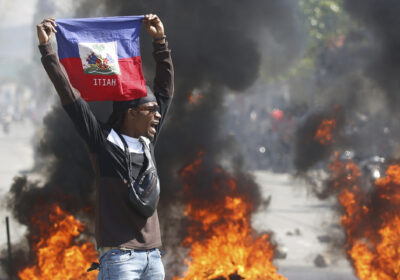
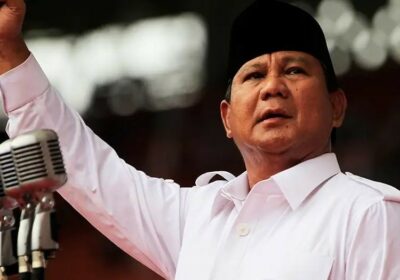

Leave a Reply